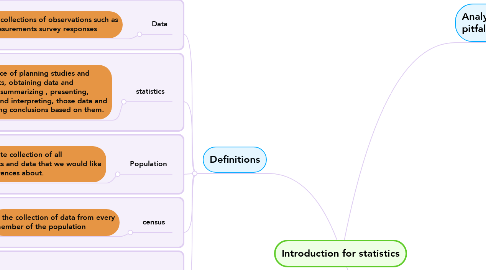
1. Definitions
1.1. Data
1.1.1. are collections of observations such as measurements survey responses
1.2. statistics
1.2.1. is the science of planning studies and experiments, obtaining data and organizing summarizing , presenting, analyzing and interpreting, those data and then drawing conclusions based on them.
1.3. Population
1.3.1. is the complete collection of all measurements and data that we would like to make inferences about.
1.4. census
1.4.1. is the collection of data from every member of the population
1.5. sample
1.5.1. is a subcollection of members selected from a population.
1.5.1.1. because populations are often very large so we obtain data from a sample and then use them to form a conclusion about population.
2. Process of statistical study
2.1. prepare
2.1.1. context
2.1.1.1. e.g, people with larger brains tend to have higher IQ scores.
2.1.2. sources of data
2.1.2.1. such as Newspapers, researches, survey, and physicians.
2.1.3. sampling method
2.1.3.1. voluntary response sample or self-selected sample is one in which the respondents themselves decide whether to be included.
2.2. analyze
2.2.1. graph and explore
2.2.2. apply statistics methods
2.2.2.1. A good statistical analysis doesn't require strong computational skills. A good statistical analysis does require using common sense and paying careful attention to sound statistical methods.
2.3. conclude
2.3.1. statistical significance
2.3.1.1. is achieved in a study when we get a result that is very unlikely occur by chance. A common criterion is that we have statistical significance by chance if 5 % or less.
2.3.2. practical significance
2.3.2.1. It is possible that some treatment or finding is effective but common sense might that the treatment isn't enough effective to be practical.
3. Analyzing Data: potential pitfalls
3.1. misleading conclusion
3.1.1. we should carefully avoid making statements not justified by statistical analysis specially for those who have no understanding of statistics.
3.2. sample data reported instead of measured
3.2.1. You should take measurements yourself instead of asking subjects to report results. because they may fake it.
3.3. loaded Questions
3.3.1. survey questions have to be worded carefully to not get misleading results.
3.4. Order of Questions
3.4.1. sometimes survey questions are unintentionally loaded by such factors.
3.5. Nonresponse
3.5.1. occurs when someone either refuse to respond to a survey questions or is unavailable.
3.6. percentages
3.6.1. we should know that % or "percent" really means " divided by 100. or it will mislead or unclear the percentages.
